
Red pineapple (Ananas comosus var. bracteatus) was cultivated for fiber or fruit juice, and as a living hedge, and it is now a pantropical ornamental. The bracteatus plant is conspicuous for its bright pink-to-red fruit. The sequenced pineapple genomes partly validated ‘one-step operation’ for domestication of clonally propagated crops and revealed candidate genes for self-incompatibility. The photograph was taken 1 month after flowering.

F153, a semi-upright plant with broad, deep green leaves. The fruit is relatively large and has a certain cold tolerance. It has a shorter maturity period compared to conventional varieties and yields 20%-30% higher. The fruit has a thick skin, making it resistant to transportation and storage. The flesh is crisp with high sugar content and low acidity.

The plant has a height of 92-120 cm and a crown width of 91-119 cm. It has about 40-50 mature leaves, which are approximately 98-145 cm long. The leaves are hard and have white stripes. The leaf margins are serrated and curved towards the leaf tip. The inflorescence is composed of 37-50 small flowers arranged in a spiral pattern. The aggregate fruit is cylindrical, measuring 9.9-16.5 cm in length and 8.7-10.5 cm in diameter. It weighs about 550-998 g. The inflorescence axis is large, and the bracts covering the flowers and fruits are arranged in a spiral pattern. These bracts range in color from bright pink to red during the flowering period, making the inflorescence vibrant. There are 37-50 small fruits, with fruit eyes measuring 10.8-13.0 mm deep. There is one crown bud, measuring 32-41 cm in height, and 15-20 crown branch buds. The base of the fruit often has 2-3 branch buds, and there are 2-3 suckers on the stem and 1-3 underground shoots.
The fruit has a bright red skin during the fruit enlargement stage, and the bracts and sepals turn pale yellow-white when it is ripe. The fruit has low juice content, white flesh, a soluble solid content (TSS) of 13.8%, and no aroma. It has a longer storage period compared to existing edible pineapple varieties and is resistant to diseases such as water heart disease, heart rot, and black heart disease. It shows good disease resistance.
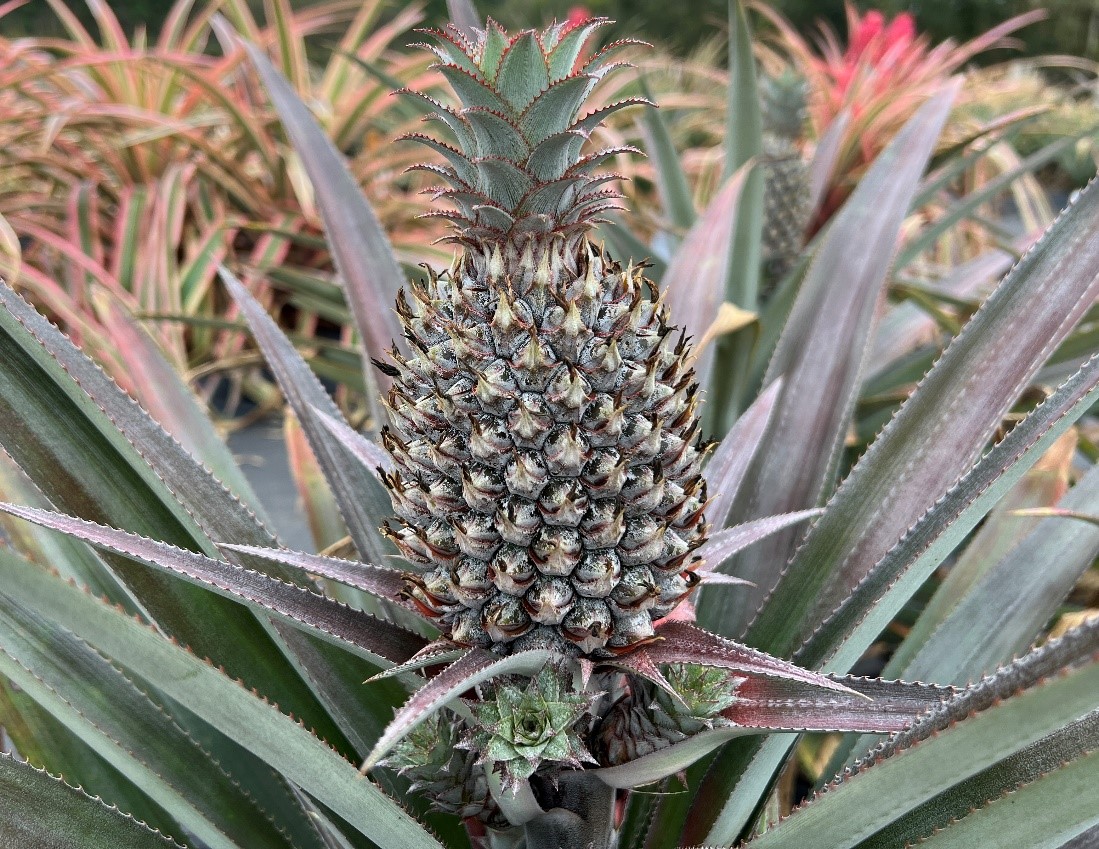
The pineapple variety "Bali" originated in the Philippines and was later introduced to Guangxi, Guangdong, Fujian, and other regions in China. The plants are medium to large in size, with a relatively flat and spreading growth habit. The leaves are smooth-edged with spines, arranged neatly. The plant height ranges from 75 to 110 cm. The leaves are large, green, with anthocyanins coloring the center, a thin layer of powder on the upper surface, and a thick white powder on the back. The fruits are of medium size, with an average weight of about 750-1500 g. The skin is thick, and the fruit eye is deep. In environments with lower winter temperatures, the fruits are cylindrical or slightly conical in shape. There are 90-120 small fruits per plant, arranged neatly. The flesh is a dark yellow color, crisp in texture, with moderate juice content. It has a rich aroma, a soluble solid content of 13%-15%, and an acidity level of 0.47%. The taste is balanced between sweet and sour. It is widely cultivated in China, especially in Hainan, southern regions, the Leizhou Peninsula, and Guangxi, accounting for over 80% of the total pineapple cultivation area.

The plants are semi-erect, with a height of 92 to 120 cm and a crown width of 91 to 119 cm. Adult plants have 40 to 50 leaves, measuring approximately 98 to 145 cm in length, with white stripes; the leaf edges are serrated. The head-shaped inflorescence consists of 37 to 50 sessile small flowers arranged spirally. The aggregated fruit is elongated cone-shaped, measuring 9.9 to 16.5 cm in length and 8.7 to 10.5 cm in diameter, weighing approximately 550 to 998 g. The inflorescence axis is large, and the bracts on the flowers and fruits are arranged spirally like tiles. The bracts have a bright pink to red color during the flowering period, making the inflorescence vibrant. There are 37 to 50 small fruits, with a depth of 10.8 to 13.0 mm for the fruit eyes. There is one crown bud with a height of 32 to 41 cm, and 15 to 20 crown axillary buds. The base of the fruit often has 2 to 3 axillary buds, 2 to 3 suckers on the stem, and 1 to 3 underground tiller buds. During the fruit enlargement stage, the skin of the fruit is bright red. After ripening, the bracts and sepals turn pale yellow-white. The fruit has low juice content, white flesh, and a soluble solid content (TSS) of 13.0%. It lacks fragrance. Compared to existing edible pineapple varieties, it has a longer storage period and shows good resistance to diseases such as water heart disease, heart rot, and black heart disease.
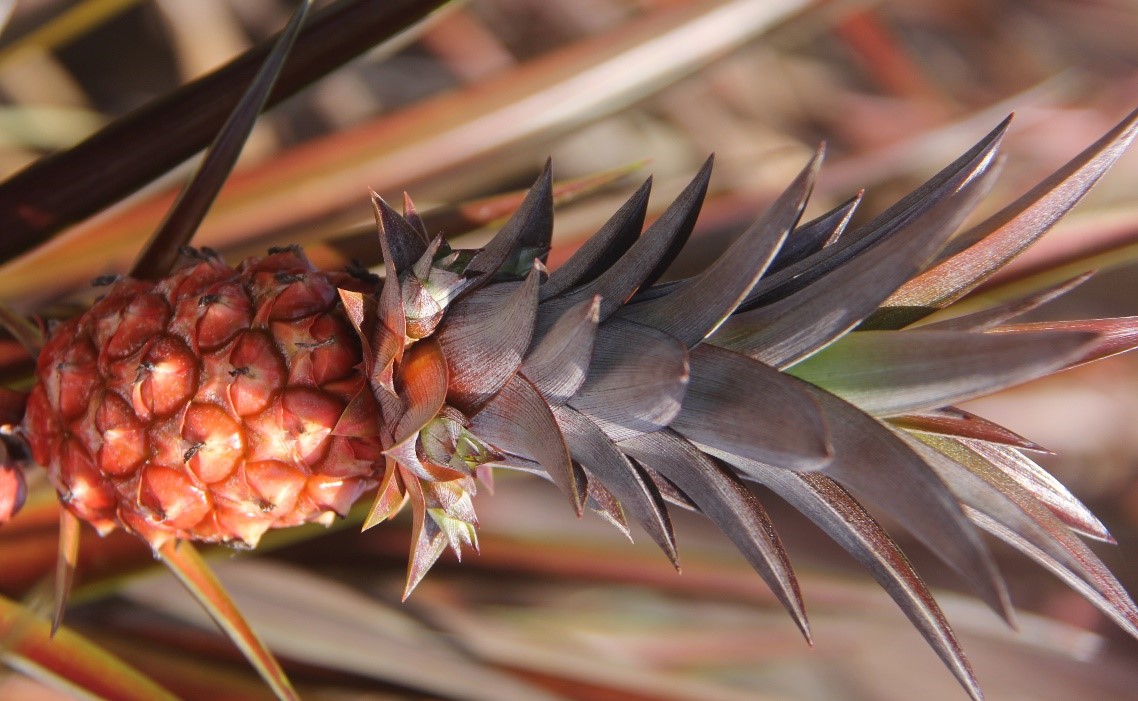
It is an important fiber and ornamental plant with red fruit skin. The flowers can reach a length of 45 cm, and the flowering and fruiting period lasts for 6 months, making it a good cut flower material. The plant is upright and can reach a height of 51.20 to 65.50 cm. It has 16 to 24 leaves, which are 53.50 to 66.10 cm long. The leaf edges are smooth and without thorns. The inflorescence is cylindrical, measuring 4.60 to 5.36 cm in length and 4.20 to 4.30 cm in diameter, weighing 58.38 g. There are 32 to 44 small fruits in each inflorescence, with a depth of 4.51 to 7.00 mm for the fruit eyes. There are no seeds. There is one crown bud, which is 11.7 to 20.3 cm long. The base of the fruit often has 1 to 3 axillary buds. Each individual flower only opens for 1 to 2 days, and each inflorescence opens for about 20 days. The fruit takes about 90 days to develop, and when it is ripe, the fruit skin is pink. The fruit has low juice content, white flesh, and a soluble solid content of 10.2%, but no fragrance.

The plant is semi-upright with a height of 56 cm and a crown width of 87-95 cm. It has approximately 28 leaves, each measuring 80 cm in length, with entire margins and spines. The inflorescence is cylindrical, measuring 11.0-13.5 cm in length and 9.3-12.0 cm in diameter. The fruit weighs between 550-800 g and has around 68 small fruits. The fruit eyes are deep, measuring 11.0-13.0 mm. There are no seeds present. There is one crown bud, measuring 23-28 cm in length. During fruit setting, the fruit skin is yellow-green. After ripening, the bracts and sepals become pale bright green. The fruit is juicy with pale yellow flesh and a soluble solid content of 15.5%. It has a sweet and slightly fragrant taste.

"YLL" is a new variety bred from the somatic cell mutation of the dwarf pineapple (Ananas comosus var. nanus). The plants are upright with a height of 20.5 to 47.2 cm and a crown width of 48 to 81 cm. The inflorescence is terminal and head-shaped, and the fruit is aggregated into a spherical shape weighing 40 to 50 g, with 24 to 35 small fruits. There is one crown bud at the top of the aggregated fruit, conical in shape, with a height of 10 to 12 cm and weighing 40.4 to 59.2 g. It has characteristics such as a short growth period, easy flowering, cold tolerance, and red fruit skin, making it suitable for cultivation in tropical and subtropical regions.
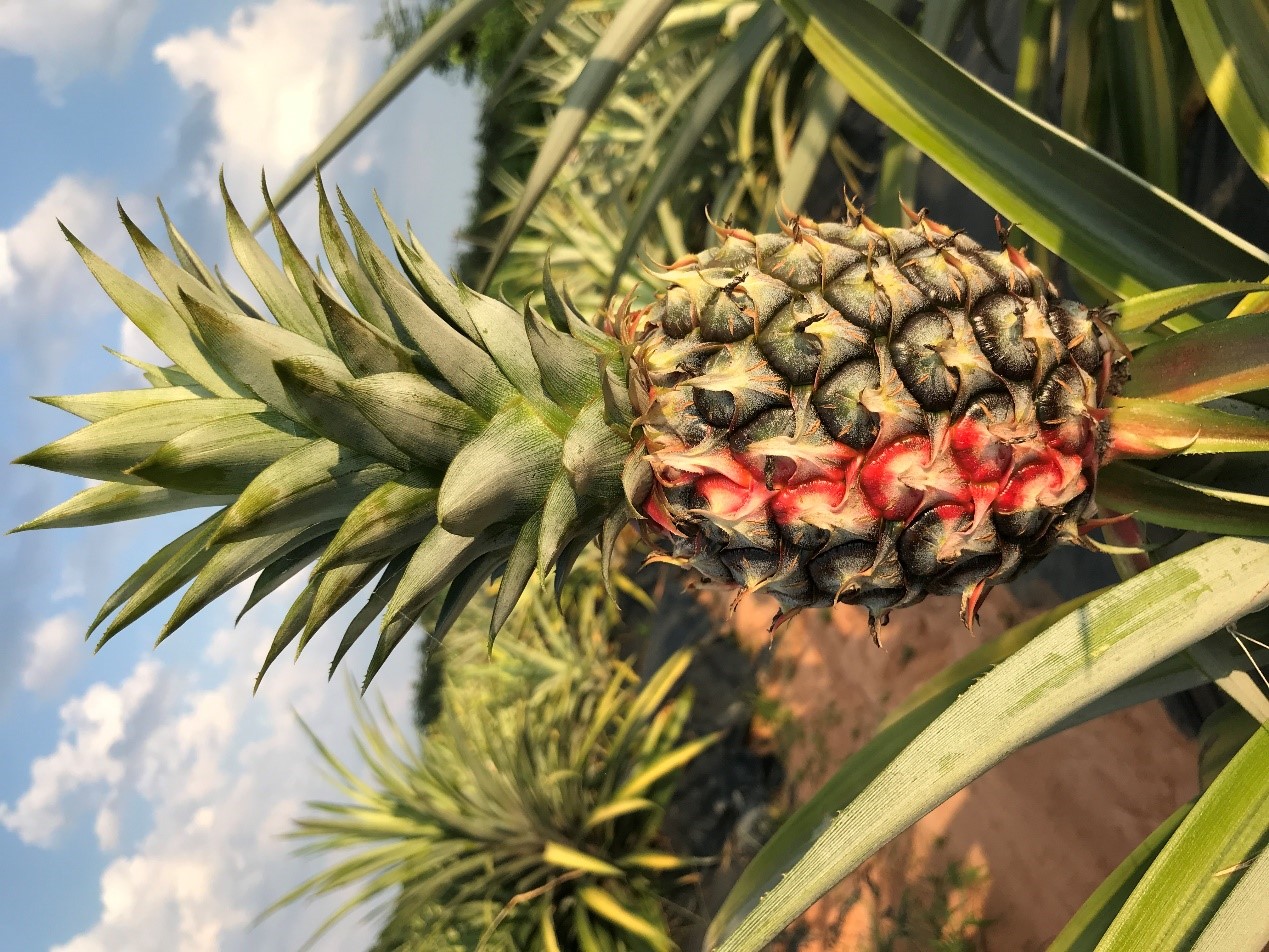
The plant is semi-upright, with a height of 77 cm. An average adult plant has 36 leaves, with a length of 78 cm. The leaves have occasional spines at the tips. The inflorescence is cylindrical, measuring 15.5 to 17.2 cm in length and 10.6 to 13.4 cm in diameter. Each individual fruit weighs between 1950 and 2150 g, and there are approximately 65 small fruits on each plant. The fruit eye depth ranges from 9.8 to 13.0 mm. There is one crown bud, measuring 20.4 to 22.2 cm in length. The fruit skin is a combination of red and green, while the flesh is yellow, juicy, and has a soluble solid content of 19.5%. It has a slight aroma and the two-tone fruit skin is very distinctive.

The pineapple variety "Yugafu" produced in Okinawa Prefecture has white flesh, leaves without spines, and a shallow fruit eye.
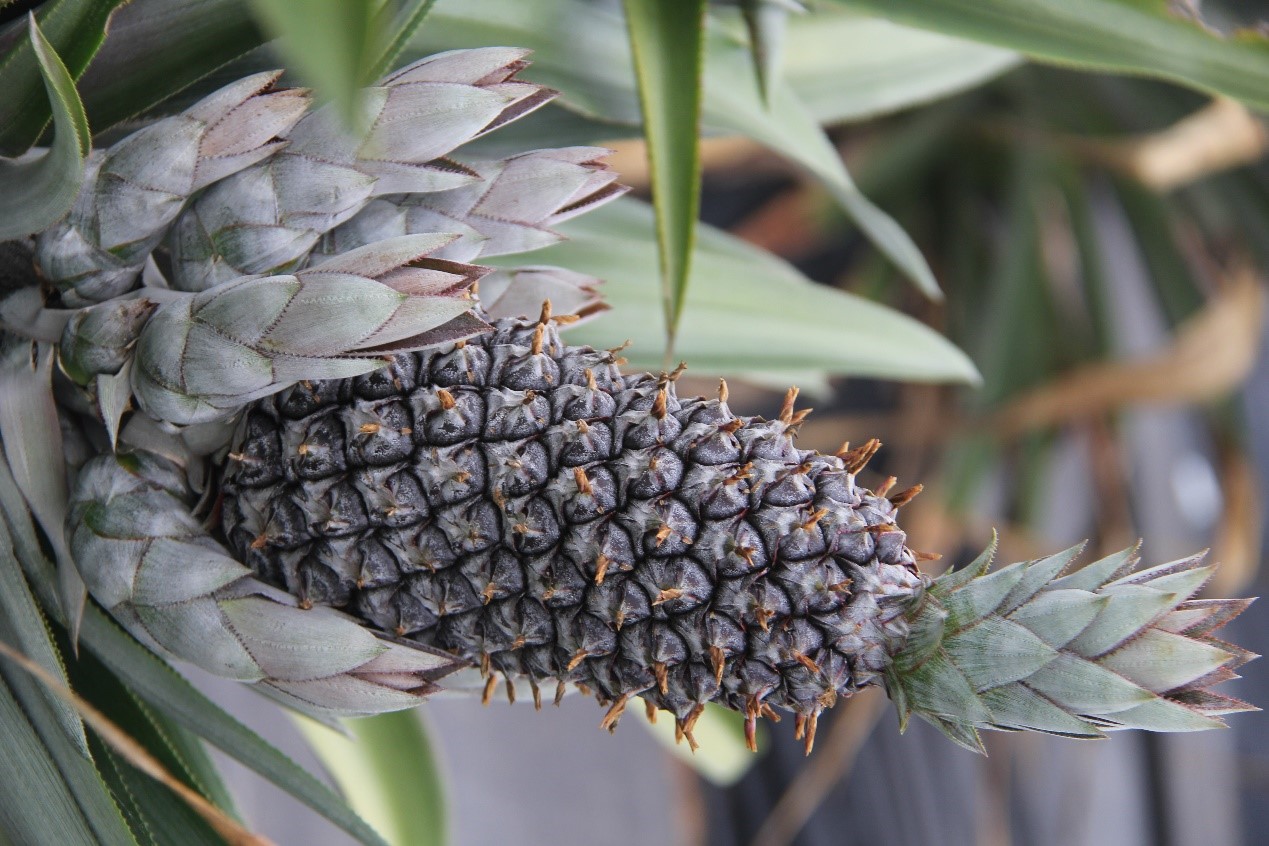
The plant is semi-upright, with a height of approximately 53.5 cm. It has 24 leaves, with a length of 61.4 cm, and the leaves are entire with spines. The inflorescence is elongated and cone-shaped, measuring 9.6 to 11.3 cm in length and 7.0 to 7.7 cm in diameter. Each individual fruit weighs between 293.2 and 337.8 g, and there are approximately 78 small fruits on each plant. The fruit eye depth ranges from 11.0 to 13.5 mm, and there are no seeds. There is one crown bud, measuring 12 to 15 cm in length. The fruit often has more than 10 axillary buds at the base. When the fruit is young, it has a dark purple color, but it turns orange-yellow when mature, along with the bracts and sepals. The fruit is juicy, with bright yellow flesh and a soluble solid content of 16.4%. However, it does not have any aroma.
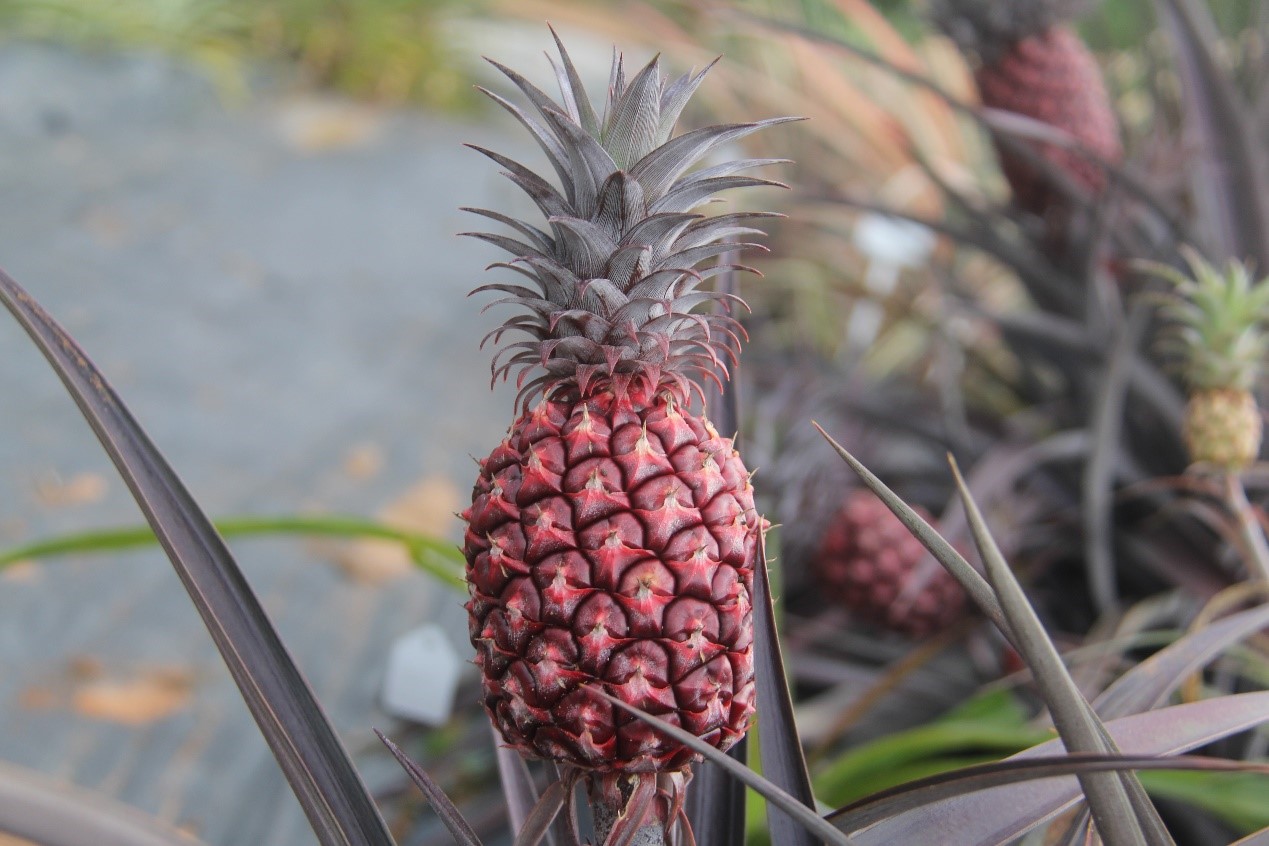
The plant is semi-upright, with a height of 31 cm and a crown width of 64-66 cm. There are 22 leaves, each measuring 51.3 cm in length, and they are completely spineless. There is 1 bract, red in color; 3 sepals, red in color; 3 petals, with the tips being blue-purple and the middle-lower parts being white. The multiple fruit is cylindrical, measuring 9.9 cm in length and 7.7 cm in diameter, with a weight of 350-400 g. It contains 100 small fruits, and the fruit eye depth is 10.5-11.4 mm. There are no seeds. There is 1 crown bud, measuring 11-20 cm in length. When the fruit is mature, the bract and calyx turn red. The soluble solid content is 10.0%, and it has a slight fragrance. One characteristic of this variety is that the fruit skin does not turn red when it is ripe.

The plant is upright and about 80.7 cm tall. The longest leaf measures 83.7 cm in length and 6.81 cm in width. The leaf edges are without spines or with a few small spines at the tips. The surface of young leaves is light green, and the plant has an open growth habit. There is one bract, which is red; three sepals, which are pink; and three petals, 8 to 10 mm long. The upper part of the petals is blue-purple, while the middle and lower parts are white, turning purplish-red after withering. The ovary is inferior with three chambers, each containing 20 to 30 ovules. The fruit is a multiple fruit and cylindrical in shape. There are 1-2 crown buds, 1-3 axillary buds at the base of the fruit, 2-3 axillary buds in the leaf axils, and 1-2 underground sucker buds. The small bracts and sepals at the base of the fruit are wrinkled. The average weight of the fruit is 1.41 kg, and the fruit eyes are even. The fruit skin is red during the first 10 days of fruit set and turns light yellow-white when ripe. The flesh is yellow to golden, with a low fiber content and a fine texture. The average soluble solids content is 19-22%, and the flavor is rich. The harvesting period is from March to July.